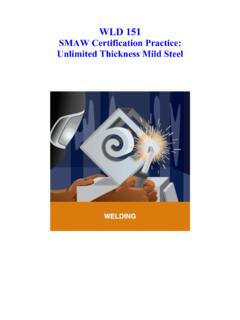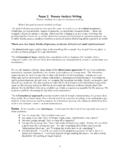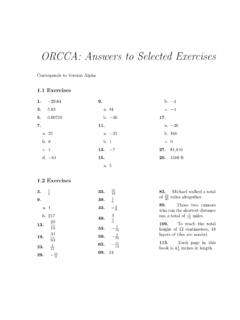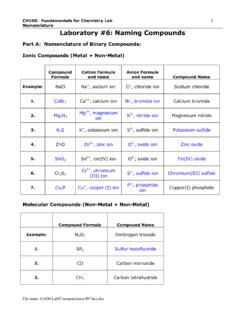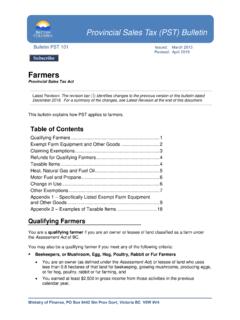Transcription of Math on Metal - PCC
1 math on Metal The Welding Fabrication Industry needs qualified welder fabricators who can deal with a variety of situations on the job. This portion of the training packet explores mathematics as it relates to industry requirements. 2 Welding math Packet Table of Contents math TOPICS Page Number HOW TO USE THIS PACKET 5-6 WHOLE NUMBERS 7 Reading whole numbers; Understanding the decimal point 8 Adding & Subtracting whole numbers 9 Multiplying whole numbers 10 Dividing whole numbers 11 USING YOUR SCIENTIFIC CALCULATOR 12 Using your calculator 13 Using the fraction key on your calculator 14-15 Checking answers for accuracy when using your calculator 16-18 FRACTIONS 19 Understanding Fractions 20-21 Relative size of fractions- Which is smaller? Bigger? 22 Reducing fractions to their lowest terms 23-24 Changing improper fractions to mixed numbers and visa versa 25-27 Adding & Subtracting fractions 28-30 Multiplying Fractions 31-33 Dividing Fractions 34-37 Converting fractions to decimals 38-40 Using your calculator to add, subtract, multiply, divide, reduce fractions and to change fractions to decimals 41-42 DECIMALS 43 Comparing Decimals to fractions 44-46 Reading & Writing Decimals 47-49 Decimal size- determining the size of common objects in decimal inches 50 Comparing Decimal sizes; Which is Larger?
2 Smaller? 51-54 Rounding decimals 55-57 3 Converting decimals to fractions 58-59 Adding Decimals 60-61 Subtracting Decimals 62-63 TOLERANCES- HOW TO CALCULATE THEM 64 Bilateral and Unilateral Tolerances 65-66 Fractional tolerances 67-68 Decimal Tolerances 69-71 Angle tolerances 72 Joint Preparation Tolerances 73-74 MEASURING TOOLS 75 Measuring with fractions- skills needed in using a ruler; reducing fractions, expressing fractions in higher terms 76-79 Ruler- reading it with accuracy 80-83 Metric ruler 84 Converting decimals to the nearest 1/16th of an inch for reading rulers 85-86 Protractor 87-90 Bevel (Angle) Finder 91-92 Micrometer 93-101 WIRE DIAMETER 102 Converting fractional wire sizes to decimal sizes 103-104 RATIO & PROPORTION 105 Introduction to ratio and proportion using the box method 106-108 PERCENTAGES 109 Solving percentage problems using the box method 110-112 ACCURATE SETTING AND ADJUSTMETNS 113 Making current adjustments (percentage reductions) 114-115 Checking and adjusting wire feed speed 116-121 Setting machine dials 122-130 4 METRIC MEASUREMENTS 131 Using your hand as a metric measuring tool 132 How big or little are linear metric measurements?
3 Body reference chart 133 Estimating length in millimeters 134 Converting to metric equivalents using the box method 135-136 Metric conversion chart 137 Metric to Metric Conversions-converting from larger and smaller metric units 138-141 Using a metric step ladder 142-145 SOLVING A FORMULA 146 Solving formulas; using Ohms law & temperature conversions as examples 147-149 Order of Operations 150-153 Squaring numbers 154-156 Dimensional analysis 157 TEMPERATURE CONVERSIONS 158 Using what you know about solving formulas to convert from Celsius to Fahrenheit or visa versa 159-160 ELECRTRC POWER PROBLEMS 161 Using what you know about solving formulas to solve electric poser problems 162-163 GEOMETRY 164 Understanding circles and Pi 165-167 Squaring numbers 168-170 Square roots 171-172 Area of rectangles 173-174 Area of triangles 175-178 Construction with angle/Bevels 179-180 Area of circles 181-185 Squaring your corners 186-187 Squaring off & finding the center of your rectangle 188-192 Geometric Construction for Fabrication on Metals 193-198 Forming pipes and tubes out of flat Metal 199-200 Making trigonometry Work for You- finding missing 201-227 5dimensions.
4 Fabrication CALCULATING THE COSTS OF A WELDING JOB 228 What is Included in the Cost of Welding? 229 Calculating Arc Time vs Prep Time- Using Percentages 230-231 Calculating Direct Labor Costs 232-235 Operating Factor 236 Overhead Costs 237 Calculating the Cost of Steel 238-242 Calculating the Cost of Welding Consumables 243-248 Calculating the Cost of Materials 249-252 HEAT INPUT 253 Heat input lab using current, voltage and speed 254-260 6 HOW TO USE THIS PACKET This packet is meant to be used as a reference guide and a learning tool. It contains nearly all of the math worksheets that were developed for the math on Metals Project which have been interspersed throughout all of the welding packets. The worksheets have been collected, edited, and rearranged in an order that we hope will be helpful to all welding students, whether you are taking just a few classes for welding skills upgrade or you are a degree or certificate seeking student.
5 When compiling this math reference packet, care was taken to build on skills, starting from the most basic (whole number, addition, subtraction, multiplication, division) moving on quickly to fractions, decimals, ratios, percentages, formulas and geometry. Throughout the math worksheets and this packet, applications of the skills have been tied directly to the welding projects and problems you will encounter in the classroom and on the job. Although the skills build in a logical order, this reference guide is not necessarily meant to be started at the beginning and moved through on a step-by-step basis, but rather it is intended to be used to fill in math knowledge gaps and to provide examples of math applications that would be helpful to welders. Using the detailed table of contents you should be able to locate the specific math application and also the background theory that you may need in order to gain a thorough understanding of any math related problem you encounter.
6 An example might be that you are having trouble understanding how to calculate heat input on a welding job. You could go to the heat input section found in the table of contents. If all you need is a refresher on the formula it is located there. If you discover that you also need more information on how to solve formulas, then you would look to the formula section for more explanation on how to use a formula and order of operation. At the end of each application worksheet you will find a list of other worksheets contained in this packet that may be helpful for a fuller understanding of the application worksheet. 7 Although the math in this packet is meant for the most part to be both self explanatory and self paced, you may encounter problems in using this packet. Please ask your instructor for clarification. Some answers have been provided in the math packet itself, your instructor will have separate detailed answer sheets that they can make available to you at their discretion.
7 8 WHOLE NUMBERS ADDING, SUBTRACTING, MULTPILYING & DIVIDING Applications: All welding applications Measurement Blueprint reading 9 READING NUMBERS Understanding the Decimal Point The most important part of any number is the decimal point. Every number is written around a decimal point. Whole units are located to the left of it, and anything less than a whole unit is located to the right of it. The decimal point may be considered as a point of reference, identifying each digit by its relative position. For example, the following number (1, ) is read: one thousand, five hundred thirty-four and three hundred sixty-seven thousandths. This means there are 1,534 whole units, plus 367/1000 of one unit. When you see a decimal point in a number, you read it as and. The number is read thirty six and fifty five hundredths.
8 To learn more about reading decimals and what they mean turn to the section on decimals. The following are examples of numbers and how they are read: 12,978, Twelve million, nine hundred seventy-eight thousand, five hundred forty-three and eight hundred ninety-six thousandths. 1,423, One million, four hundred twenty-three thousand, six hundred 670, Six hundred seventy thousand, eight hundred nine and nine tenths. 56,206 Fifty-six thousand, two hundred six. 7,000 Seven thousand. 3,980 Three thousand, nine hundred eighty. 10 ADDITION AND SUBTRACTION OF WHOLE NUMBERS Addition is the process of combining two or more numbers to obtain a number called their sum or total. The numbers being added are Addends. Addend Addend The result is the Sum.
9 Sum To prove the accuracy of your addition, you merely reverse the order and add again. Subtraction is the process of finding the difference between two numbers. The number from which another is to be subtracted is the Minuend. The number to be subtracted from another is the Subtrahend. The result is the Difference or Remainder 890 Minuend -78 Subtrahend 812 Difference To prove the accuracy of your subtraction, you add the Difference to your Subtrahend and the result should be the same as your Minuend. 812 difference +78 Subtrahend 890 Sum Note: when using your calculator to add numbers you can enter the numbers (addends) in any order. Example; 5 + 2 = 7 or 2 + 5 = 7 . When you subtract using the calculator be sure and enter the Minuend first (even if it is a smaller number) then enter the subtrahend in order to get the difference.
10 Example: 7 - 2 = 5 If you enter 7-2 incorrectly (entering the 2 first) you will get a negative number (-5) that is an incorrect answer. 11 MULTIPLICATION OF WHOLE NUMBERS Multiplication is repeated addition. The number to be multiplied is the Multiplicand. The number by which another is multiplied is the Multiplier. The result of the multiplication is the Product. Although the multiplicand and multiplier are 1245 Multiplicand Inter-changeable, the product is always the same. x 19 Multiplier 11,205 1245_ 23655 Product If one number is larger than the other, the larger number is usually used as the multiplicand.


